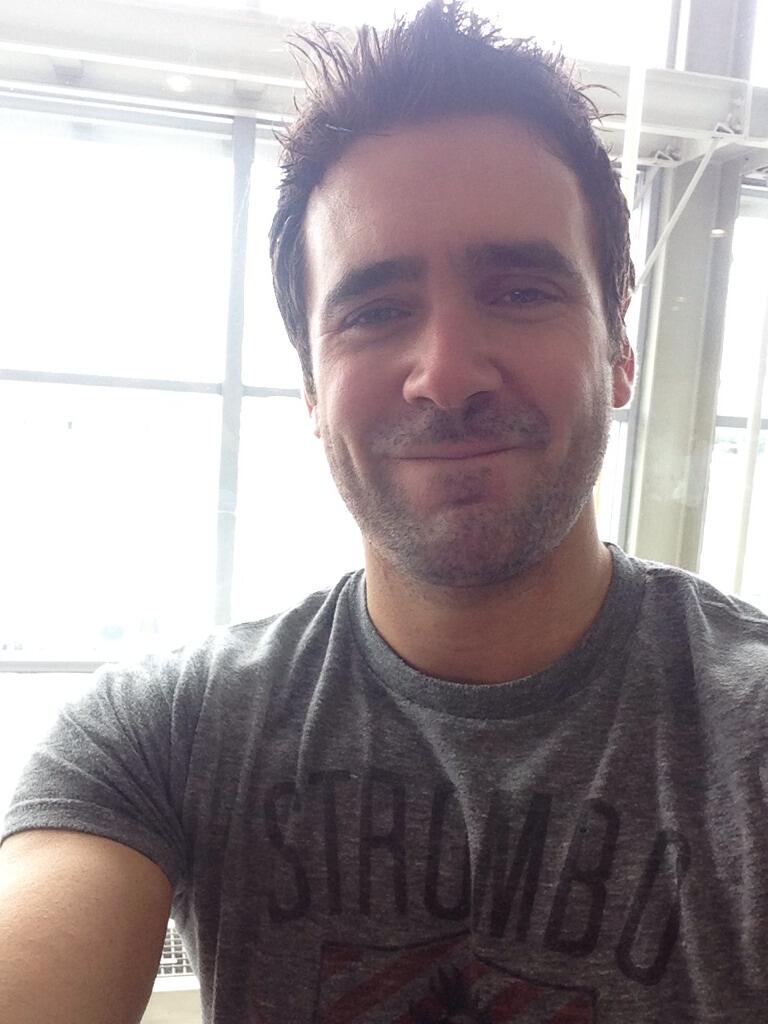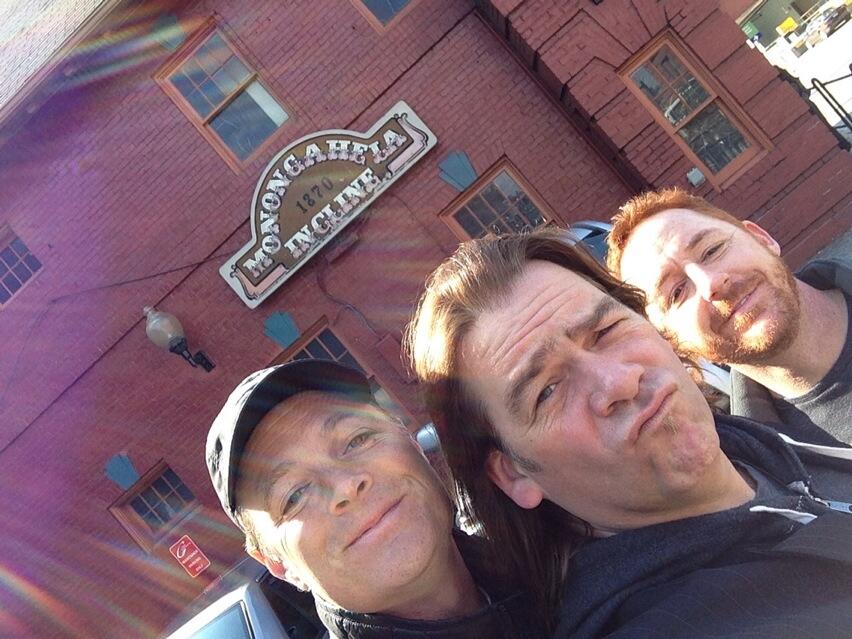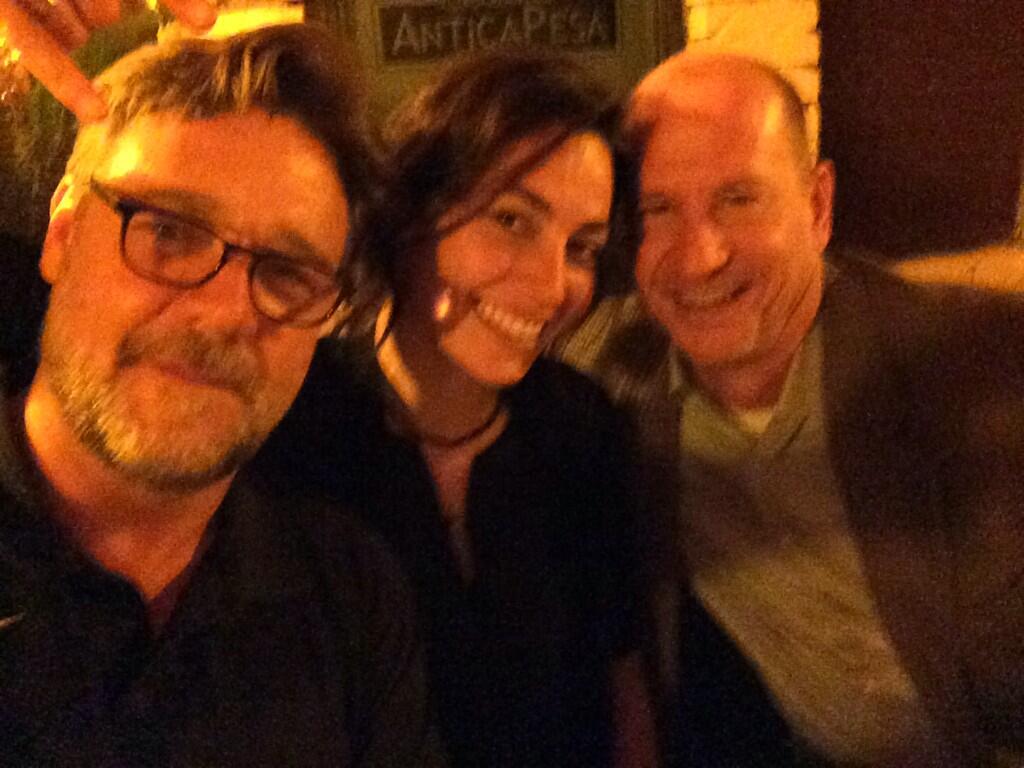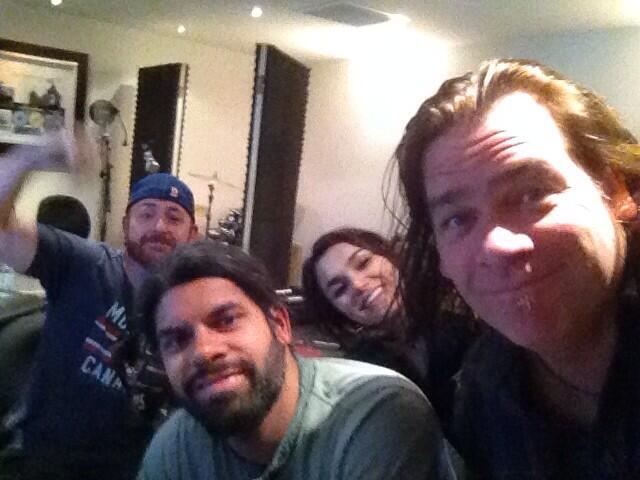My statistics from Blogger tell me that one of the most popular posts I wrote was on Great Big Sea and selfies published last year. The Great Big Sea selfies were being taken on the Great Big Sea XX tour last year in various places around America and Canada. The post is continually revisited and I have had over 500 hits. So I decided to revisit the topic of selfies.
This time I have included a collection of selfies from Russell Crowe, Alan Doyle, Allan Hawco, Scott Grimes and the events of the past 6 months on Twitter. They include the Indoor Garden Party in Australia, Russell Crowe’s 50 th birthday in Pittsburgh while making a movie (attended by long time friends Alan Doyle, Allan Hawco and Micheal Bluie), Allan Hawco’s trip to South Africa to film A Book of Negroes and even one from Russell Crowe holidaying in the Whitsundays in Australia at the beginning of the year.
It was difficult to pick a favourite as I love them all. However, my favourite for this period goes to Alan Doyle and his beautiful dog Molly. I also loved a selfie of Allan Hawco and Lynda Boyd taken four days ago before the beginning of the filming of the final season of Republic of Doyle. (This photo was not included as I was unable to copy it from Allan Hawco’s Instagram account). Many thanks to the boys for sharing with the fans.
As most of us know, selfie was Oxford Dictionaries 2013 International Word of the Year and as a consequence there were many great articles about this cultural and social phenomena. The Oxford Dictionary online describes a selfie as “A photograph that one has taken of oneself, typically taken with a smartphone or webcam and uploaded to a social media website”. Wikipedia (2014) adds a bit more to the definition “They are often casual and are typically taken with a camera held at arm’s length or in a mirror”. (A bit more difficult than it seems, for a good one anyway). I imagine our boys do it for the same reason as most people do. Selfies are easy to create and share at a particular time and place, and give them control over how they present themselves to others.
“The Meanings of the Selfie” by James Franco was published on 26 December 2013 in The New York Times. This article was chosen deliberately from a male perspective about his professional and personal use of selfies (as distinct from a female perspective and a feminist analysis and comments). James Franco is an actor, writer and director. He writes in his concluding comments “I am actually turned off when I look at an account and don’t see any selfies, because I want to know whom I’m dealing with. In our age of social networking, the selfie is the new way to look someone right in the eye and say, “Hello, this is me”.








(no copyright infringement intended for the above photographs taken from the official Twitter accounts of Russell Crowe, Alan Doyle, and Allan Hawco)
Note... the photos by Scott Grimes seem to be blocked.
“The Meanings of the Selfie” by James Franco in The New York Times on 26 December 2013. (no copyright infringement intended)
Selfies are something new to me, but as I have become increasingly addicted to Instagram I have been accused of posting too many of them. I was called out on the “Today” show, and have even been called the selfie king.
Maybe this is so, but only because I’ve learned that the selfie is one of the most popular ways to post — and garner the most likes from followers. The likes spin out of control for selfies of me and my two handsome brothers, especially Dave, the other actor, whose image pulls in its own legion of teenage fans.
I can see which posts don’t get attention or make me lose followers: those with photos of art projects; videos telling the haters to go away (in not so many words); and photos with poems. (Warning: Post your own, and you’ll see how fast people become poetry specialists and offer critiques like “I hate you, you should die.”)
I can see which posts don’t get attention or make me lose followers: those with photos of art projects; videos telling the haters to go away (in not so many words); and photos with poems. (Warning: Post your own, and you’ll see how fast people become poetry specialists and offer critiques like “I hate you, you should die.”)
But a well-stocked collection of selfies seems to get attention. And attention seems to be the name of the game when it comes to social networking. In this age of too much information at a click of a button, the power to attract viewers amid the sea of things to read and watch is power indeed. It’s what the movie studios want for their products, it’s what professional writers want for their work, it’s what newspapers want — hell, it’s what everyone wants: attention. Attention is power. And if you are someone people are interested in, then the selfie provides something very powerful, from the most privileged perspective possible.
We speak of the celebrity selfie, which is its own special thing. It has value regardless of the photo’s quality, because it is ostensibly an intimate shot of someone whom the public is curious about. It is the prize shot that the paparazzi would kill for, because they would make good money; it is the shot that the magazines and blogs want, because it will get the readers close to the subject.
We speak of the celebrity selfie, which is its own special thing. It has value regardless of the photo’s quality, because it is ostensibly an intimate shot of someone whom the public is curious about. It is the prize shot that the paparazzi would kill for, because they would make good money; it is the shot that the magazines and blogs want, because it will get the readers close to the subject.
And the celebrity selfie is not only a private portrait of a star, but one also usually composed and taken by said star — a double whammy. Look at Justin Bieber’s Instagram account (the reigning king of Instagram?), and you will find mostly selfies. Look at other accounts with millions of followers — like that of Taylor Swift or Ashley Benson (of the TV show “Pretty Little Liars”) — and you’ll find backstage selfies, selfies with friends, selfies with pets.
These stars know the power of their image, and how it is enhanced when garnished with privileged material — anything that says, “Here is a bit of my private life.”
I’ve found that Instagram works much like the movie business: You’re safe if you trade “one for them” with “one for yourself,” meaning for every photo of a book, painting or poem, I try to post a selfie with a puppy, a topless selfie or a selfie with Seth Rogen, because these are all things that are generally liked.
Now, while the celebrity selfie is most powerful as a pseudo-personal moment, the noncelebrity selfie is a chance for subjects to glam it up, to show off a special side of themselves — dressing up for a special occasion, or not dressing, which is a kind of preening that says, “There is something important about me that clothes hide, and I don’t want to hide.”
Of course, the self-portrait is an easy target for charges of self-involvement, but, in a visual culture, the selfie quickly and easily shows, not tells, how you’re feeling, where you are, what you’re doing.
And, as our social lives become more electronic, we become more adept at interpreting social media. A texting conversation might fall short of communicating how you are feeling, but a selfie might make everything clear in an instant. Selfies are tools of communication more than marks of vanity (but yes, they can be a little vain).
We all have different reasons for posting them, but, in the end, selfies are avatars: Mini-Me’s that we send out to give others a sense of who we are.
I am actually turned off when I look at an account and don’t see any selfies, because I want to know whom I’m dealing with. In our age of social networking, the selfie is the new way to look someone right in the eye and say, “Hello, this is me.”
These stars know the power of their image, and how it is enhanced when garnished with privileged material — anything that says, “Here is a bit of my private life.”
I’ve found that Instagram works much like the movie business: You’re safe if you trade “one for them” with “one for yourself,” meaning for every photo of a book, painting or poem, I try to post a selfie with a puppy, a topless selfie or a selfie with Seth Rogen, because these are all things that are generally liked.
Now, while the celebrity selfie is most powerful as a pseudo-personal moment, the noncelebrity selfie is a chance for subjects to glam it up, to show off a special side of themselves — dressing up for a special occasion, or not dressing, which is a kind of preening that says, “There is something important about me that clothes hide, and I don’t want to hide.”
Of course, the self-portrait is an easy target for charges of self-involvement, but, in a visual culture, the selfie quickly and easily shows, not tells, how you’re feeling, where you are, what you’re doing.
And, as our social lives become more electronic, we become more adept at interpreting social media. A texting conversation might fall short of communicating how you are feeling, but a selfie might make everything clear in an instant. Selfies are tools of communication more than marks of vanity (but yes, they can be a little vain).
We all have different reasons for posting them, but, in the end, selfies are avatars: Mini-Me’s that we send out to give others a sense of who we are.
I am actually turned off when I look at an account and don’t see any selfies, because I want to know whom I’m dealing with. In our age of social networking, the selfie is the new way to look someone right in the eye and say, “Hello, this is me.”


